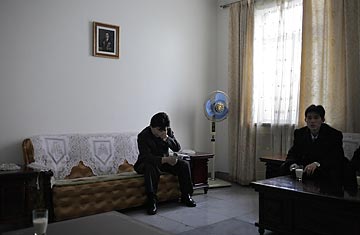
Executives at a factory in Pyongyang.
In 2007 and 2008, photojournalist Tomas Van Houtryve visited North Korea by infiltrating a communist solidarity delegation. In the final story in his three-part TIME.com series, Van Houtryve recounts the almost-invention of the North Korea Chocolate Company.
On the final day of my first trip to North Korea, my guides reached out to me. "We are trying very hard to get investors into the DPRK." They asked me to recruit people at home interested in doing business in North Korea.
I already had an exclusive set of photos from inside hospitals, schools and even Pyongyang's elite military academy. But the idea of being the first Western photographer to visit a North Korean factory was very tempting. I asked for a list of industries where Korea was looking for foreign investment. One of them, chocolate, sounded particularly strange for a country never far from the brink of starvation.
After I left Pyongyang, I began searching for a journalist willing to pose as a chocolate consultant. Eventually I found Antoine Dreyfus, a reporter for a French weekly. He would travel to North Korea under the pretext of doing a market study for the confectionary industry. I would return to Pyongyang with him, playing his assistant with a background in product marketing.
We studied chocolate production and assembled props: a fake business website, false business cards, product catalogues and samples. In February I was back in Pyongyang. I passed through passport control without a hitch and that evening Antoine and I were invited to a lavish dinner followed by karaoke. Two heavily made-up girls crooned as the screens displayed lyrics over images of charging tanks and rapidly firing surface-to-air missiles. I already knew the songs.
Our first major test would be a one-on-one meeting with North Korean foodstuff factory directors. I had seen enough fully scripted fictional performances by the Koreans by now, that I was sure we could pull off our own. Antoine would drill the Koreans with a series of questions about numbers — wages for semi-skilled workers, availability of cocoa, milk and sugar. I would present our marketing proposal. Traditional advertising mediums such as billboards, magazine, and television advertisements are forbidden in Korea, so I had an alternative plan to create a nation of chocolate lovers.
When we filed into the meeting room the next day, two serious Korean gentlemen dressed in black were waiting for us on red velour arm chairs. A Korean-French translator was provided. Our minders sat on the side to listen. When it came time to deliver my presentation, I stood. "I have been told that the most joyful day in your calendar is the birthday of the Great Leader. I propose a chocolate festival in every major North Korean city to correspond with this holiday. Special packaging can celebrate the various feats of your leaders. For the first two years, we will offer our product for free, but later children will beg their parents for it, as they do now in Europe. Imagine a population of 23 million people who have never tasted chocolate, turned into a nation of chocolate lovers that will last for generations..."
I finished my presentation by handing out chocolate samples to the factory directors. They brushed them aside, and politely explained they were not looking to produce chocolate for the local population. North Korea has isolated tourism zones where South Koreans can visit on tightly controlled one-day bus trips. According to the factory director, the South Koreans were always curious about the quality of North Korean goods, and eagerly bought snacks and souvenirs. Currently, the North buys Chinese chocolate, strips off the wrappers and re-packages it with North Korean labels. But Chinese chocolate is pretty bad. They wanted European chocolate know-how to make something that would impress the South. They were not looking to sell millions of chocolates, just enough to stock a few gift shops.
Read part 1 and part 2 of Tomas Van Houtryve's "Journey to North Korea."
